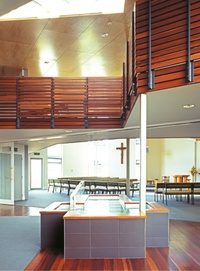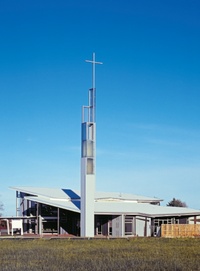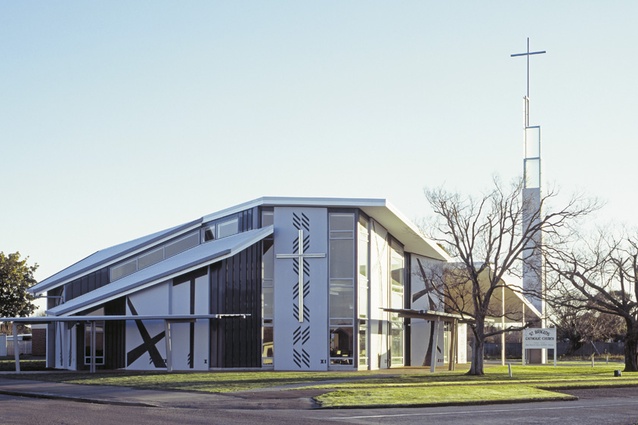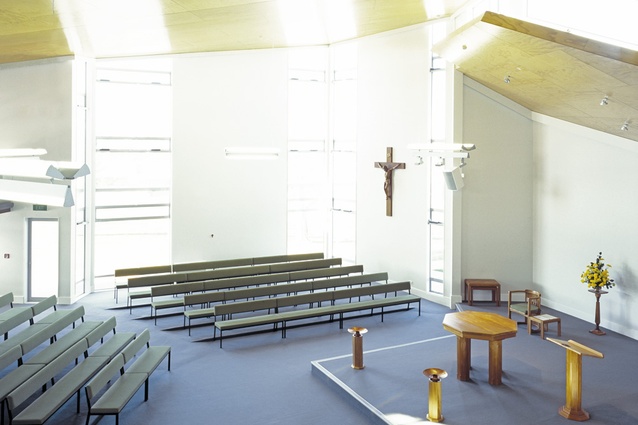Church with new angles
Void Architecture blends religious and Maori traditions for this Manawatu church.
As Catholics in possession of a smartphone will know, the Vatican has recently joined the digital worlds of social media and mobile technology. Rather than wait until you can get to a confessional to seek counsel with an actual priest, it is now possible to go through the sacrament of confession and make amends for your sins on the run (figuratively speaking) using an application downloaded for a mere $1.99. This represents a change in image for the church and exemplifies the way the institution is being redefined for the twenty-first century. Collaterally, the idea of personalisation of shared experience gleaned from outreach in the virtual world has infiltrated building design, forever altering the destination experience.
In the design of this Catholic church and community centre in the small Manawatu town of Feilding, there is a strong sense of a repositioning of traditional authority, which allows for a more personal experience for each member of the congregation. On the exterior, Maori motifs combine with Christian symbolism to punctuate intimate moments of use where worshippers travel from station to station, touching the rough surfaces of each cross. Ultimately, the individual is transcended by the sense of community celebrated in the liturgy of the mass in a Catholic church, but this building also allows each person to make his or her own meaning.

Indeed, Aotearoan architecture like St Brigid’s Catholic Church in Feilding confirms that it is possible to respect the tradition of the past without being old fashioned about it. It responds to the Second Vatican Council’s amendment to ensure that the laity can participate in the liturgy by providing a gathering place at the many sides of an octagonal communion table. The enveloping interior with mezzanine upper level amplifies this polygonal form while preserving a processional approach on a central axis. Sound is captured and enhanced by wooden and acoustic panels, and sight lines are preserved through a gently sloping floor. A congregation can feel at home here, nestled among the natural materials and bathed in abundant light, while still aware, through the majestic height and volume of the space, that they are in a sacred space.
As befits an organisation that recognises its obligations under the Treaty of Waitangi, the building wears its biculturalism on the outside. It announces itself as a whare karakia with panels representing the Stations of the Cross designed by Manawatu artist Robert Jahnke incorporated into the external walls, and a broad marae atea marking the gathering place adjacent to the eastern doors. Echoing the tracery of the bare branches of winter trees, this calligraphic treatment of the exterior panels gives the building a black-and-white legibility, accented with red in the joinery of the doors. Green upholstery on the pews connects the seating to the lush verdure of the Manawatu plains – and, of course, Ireland – beyond the walls.
Neither basilica nor cathedral, this structure represents a new bicultural typology. It replaces an earlier church: a neo-Gothic concrete structure from the early twentieth century that was unequivocally European. Both old and new churches have been named for St Brigid, the patron saint of dairy workers. This is fitting, given that Feilding is a service centre for the dairying heartland, with the largest stock sale yards in the southern hemisphere. A polychrome plaster representation of the saint endures, with leadlight windows from the original church providing a sense of continuity with the past. Brigid herself had connections with earlier Gaelic orders and the druidic religions practised by the Celts before St Patrick reached Ireland. She was a vestal virgin in service to Brid (the ancient goddess of fire and wisdom who gave us the word “bride”). Brigid is remembered for having fashioned a cross from rushes to explain Christ’s passion to a dying pagan. The Latin cross is therefore identified with her as an educational technology, and it is appropriate that a church that bears her name also bears her symbol. Even the baptismal font, designed for full immersion for the Catholic rite of Christian initiation for adults, is cruciform.

Such layering of content and context is inherent in both the shaping of the architectural forms and their decoration. The result is a building with many local, as well as religious-historical, nuances. Located on the low-lying, flat and fertile flood plain of the Manawatu River, the building extends into space through a series of intersecting planes. The roof trends downwards, dipping toward one corner where a bell tower hoists the cross aloft. While the church references the Italian Catholic tradition with this detached campanile, customary Maori design elements hybridise with Christian symbolism to give visual form to the bicultural kaupapa. Panels of cladding are marked by the takitoru or Maori tri-stripe motif derived from a pukeko’s footprint, but also standing for the trinity of Father, Son and Holy Spirit. For Maori, the red of a swamp hen’s legs and beak confer mana on these birds, just as Christians worship the Holy Trinity.
There are other links to Christianity: the pukeko is a community dweller, existing in small populations of up to a dozen individuals. It does not fly when faced with danger, but instead walks, just as Jesus Christ walked the Way of the Cross to Golgotha. By creating variations on the abstract form of the Latin cross in conjunction with these takitoru, Jahnke, as the designer of these panels, communicates a Christian message that is also recognisably embedded in Te Ao Maori (the Maori world).
This connectedness to place and time gives the architecture its contemporary relevance. Opened up to view from the outside through the use of clear glass panels, the internal structure invites exploration, especially at night. By day, sunlight and warmth fill the main liturgical space through the east-facing windows. In this way, solid and void are alternated to create both a sense of enclosure and exposure, and the entry points for natural light measure the steps on a spiritual journey for each individual. As a social space, it provides a more memorable and transformative platform for interactivity than a cellphone, but is every bit as up to date.











